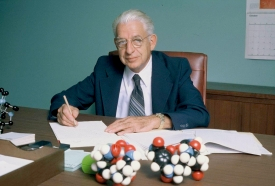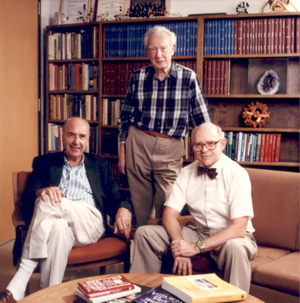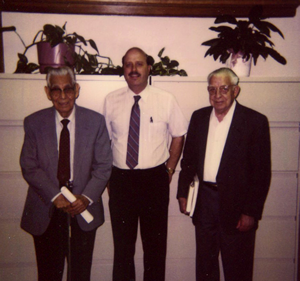
Prior to 1966, the principal role of the Department of Chemistry at Texas A&M University was to teach service courses to students in the Colleges of Agriculture and Engineering. Only a few faculty members at that time conducted research programs, and these were fairly modest, with minimal external funding and relatively few graduate students. In 1966, the Department of Chemistry (along with four other departments at Texas A&M) was formally earmarked by the University for development into those that would serve as flagship departments of a major research department. To this end, Arthur E. Martell was appointed Department Head, and given a mandate by the University administration to develop the research and graduate education in the department into nationally recognized programs of excellence.
Aided by funds provided by the University and by a National Science Foundation Development Grant, Martell was successful in hiring more than 50 new faculty members, including nine senior faculty, during the late 1960's and throughout the 1970's. Because of the substantial increase in research faculty, the number of departmental graduate students, in turn, more than tripled (to a total of > 200) during this period, and the number of postdoctoral researchers increased ten-fold to approximately 80. This growth in the department’s research and graduate programs was accompanied by the completion in 1972 of a major additional wing to the Chemistry Building, which provided more than 35,000 net sq.ft. of laboratories and offices devoted to research activities, and which contained the laboratories of Distinguished Professors F. Albert Cotton and Ian Scott, recruited by Martell from MIT and Yale University, respectively. When Martell’s term as Department Head ended in the Fall of 1980, the total number of tenure-track faculty had increased to over 50. More than $5 million in major research instrumentation had been acquired, and total funding of the department’s research programs from all sources was approximately $5.3 million per year. It should be noted that a major goal of Prof. Martell was infrastructure support for teaching and research. The massive growth required dedicated service of a strong administrative and business staff, spearheaded by the legendary Pete Rodriguez, a WWII veteran and TAMU employee for >50 years. His protégée, Ron Carter, remains as Assistant Head of the Department, continuing the legacy of loyalty and longevity set out by Mr. Rodriguez.
1980-1986

After having had only one Department Head for almost 14 years, the next six years saw three take the helm of what was now a large operation. Professor Choo-Seng Giam was instrumental in establishing, during his 3-year service as head, the department’s Industry-University Cooperative Chemistry Program (IUCCP), an industrial affiliates initiative that existed until 2009. Subsequently, Joseph B. Natowitz was appointed Head by Dean John B. Beckham, effective with the Fall 1981 semester. By the end of Natowitz’s four-year term as Head, the number of graduate students had increased to more than 250, and funding for the department’s research programs was more than $8.3 million per year. Planning and construction of a major addition to the Chemistry Building, providing more than 65,000 net sq.ft. of both teaching and research laboratories and support facilities, was initiated during Natowitz’s term as Department Head. The new wing was completed and first occupied in Spring of 1987 and contained the laboratories of Sir Derek Barton, recruited at age 68 for 12 years of continued and vigorous research activity in his “post-retirement” period at TAMU, College Station. This period also saw major advances in research support facilities with professional scientific staff—the early dream of Art Martell-- through the department’s Center for Chemical Characterization and Analysis (CCCA), which combined NMR, MS, XRD, and elemental analysis services under a single administrative oversight.
1986-1994

Another sustained period of growth developed in the years of 1986-1994 during which time renowned inorganic chemist and Dean of the College of Science John P. Fackler appointed Michael B. Hall as Head in Fall 1986. Hall served two four-year terms, during which period 13 new faculty were hired, including three senior faculty and the graduate student population stabilized at 250-260 by the end of Hall’s term as Head. The three oldest wings of the Chemistry Building underwent substantial renovations as part of two major projects during the late 1980's and early 1990's. These renovations provided approximately 70,000 net sq.ft. of substantially upgraded and modernized laboratory, office, and support spaces in these areas of the building.
1994-2005
During the last year (1993-94) of Hall’s second four-year term, a comprehensive review of the department’s programs by an external committee recommended that the department’s experienced leadership should continue with internal candidates as Head, resulting upon unanimous recommendation of a faculty search committee in the appointment of Professor Emile A. Schweikert as the new Department Head, effective in Fall 1994. Schweikert’s term as Department Head saw a resurgence in several areas of departmental operations. A total of 15 new faculty were hired between 1995 and 2005—along with the departure, retirement, or death of 10 research-active faculty, including 7 senior faculty. The department’s Division of Biological Chemistry was established from among several existing faculty in 2002. Research funding increased substantially during this period, to a total of more than $14.4 million per year in 2003, of which $9.7 million was from federal sources. During his re-appointment negotiations in 1998 and 2002, Schweikert was successful in restoring a substantial portion of the non-salary operating funds that had been removed from the departmental budget in previous years. He was also able to establish budgeted funding through the Vice-President for Research for certain departmental analytical instrumentation services. Increased emphasis has also been placed on extending and strengthening departmental interactions with industry. Unfortunately, the department again lost a substantial portion of its non-salary operating budget (as did many other departments on campus) in 2003, as a means of partially funding President Gate’s Faculty Re-Investment Program, a four-year University-wide faculty hiring initiative. This has again required careful re-allocation and prioritization of departmental financial resources.
2005-2012
In Spring of 2005, in the penultimate year of Schweikert’s third and final term as Department Head, Dean Newton arranged another review of departmental programs and operations by an external committee, with particular emphasis on assessment of the graduate program, in preparation for selecting Schweikert’s successor. The visiting committee concluded that the Chemistry Department continued to be the flagship science department at TAMU and had made substantial progress in faculty development and in improvement of research and instructional programs during Schweikert’s 12-year tenure as Department Head, but that several issues still required further, and in some cases urgent, attention. Well known mass spectroscopist David H. Russell was designated as the new Department Head, effective in Fall 2006.
The department made substantial progress during Russell’s tenure as Head toward addressing several of the most critical issues that were cited by the external review committee. Chief among these has been faculty hiring, at both the junior and senior levels. Since the 2006-07 academic year, the department hired a total of 11 faculty, including six senior faculty. Three of these new faculty, including one senior hire, were in the area of Biological Chemistry, which substantially increased the department’s strength in this field. Unfortunately, this success in hiring new faculty has again been tempered by the loss, due to retirement or departure, of nine faculty, including five senior faculty, during the period 2006-2012. Funding for faculty research programs, has increased substantially since 2006, largely due to the new faculty hires during this period. Research funding for calendar year 2011, for example, was $19.2 M, of which $15.4 M was from federal sources. This represents an increase of more than 30% from calendar year 2007, for which the corresponding figures were $14.4M and $11.4M, respectively.
2014-2016

In 2016, the year of the 50th anniversary of the Martell era, Simon North assumed the position as Head.
Francois Gabbai served as the youngest appointed Head of the TAMU Department of Chemistry. His successes included junior faculty hiring and the approbation of funds for renovation of various floors and wings of the Chemistry building complex.
